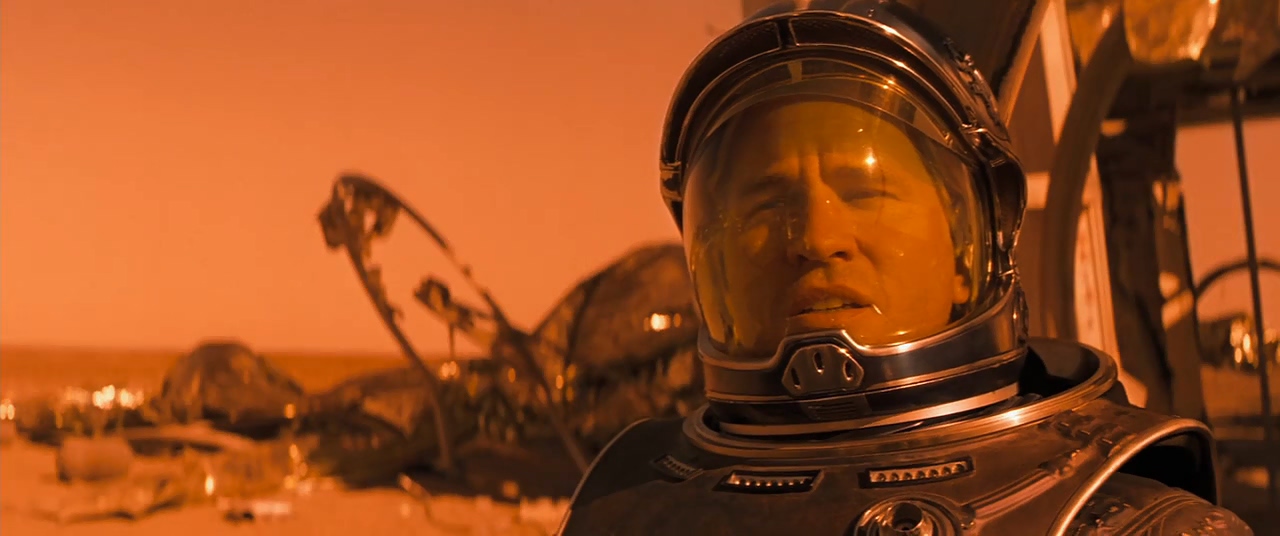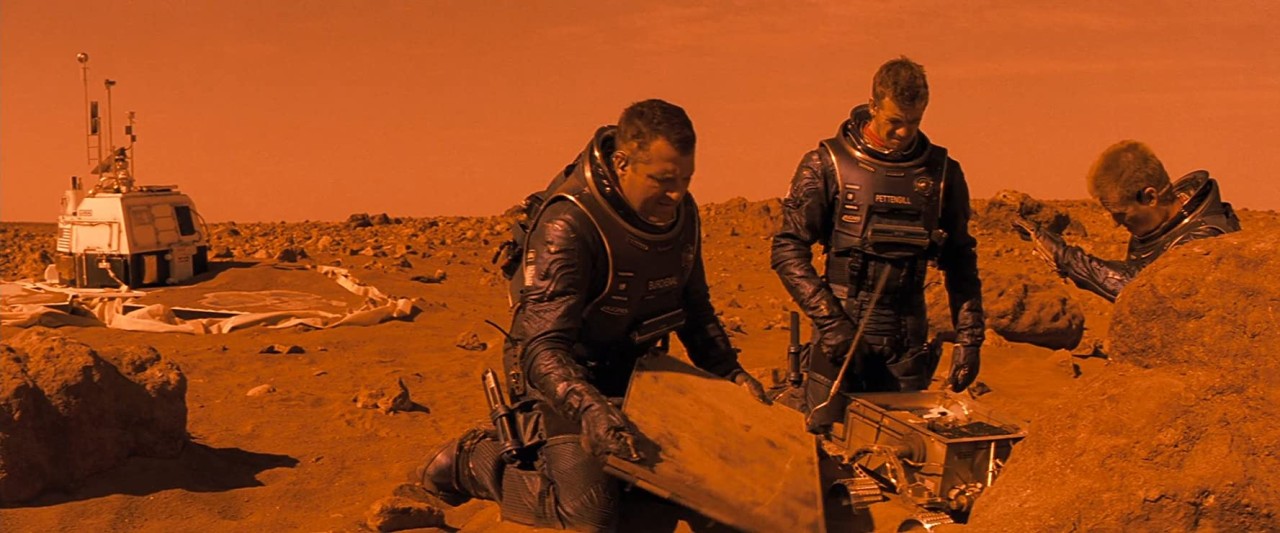USA. 2000.
Crew
Director – Antony Hoffman, Screenplay – Jonathan Lemkin & Chuck Pfarrer, Story – Chuck Pfarrer, Producers – Bruce Berman, Mark Canton & Jorge Saralegui, Photography – Peter Suschitzky, Music – Graeme Revell, Visual Effects Supervisor – Jeffrey A. Okun, AMEE Effects – Cinesite (Supervisor – Thomas J. Smith), Additional Visual Effects – Digital Domain (Supervisor – Frank Nash), Digital Filmworks, Flash Film Works (Supervisor – William Mesa), Hammerhead Productions, Illusion Arts (Supervisors – Syd Dutton & Bill Taylor), Metrolight Studios, Pixel Magic & Rhythm and Hues, Miniature Effects – Grant McCune Design, Bug Design – Patrick Tatopolous, Special Effects Supervisor – Tad Pride, Production Design – Owen Paterson. Production Company – NPV Entertainment/Warner Bros/Village Roadshow.
Cast
Val Kilmer (Gallagher), Carrie-Ann Moss (Commander Bowman), Tom Sizemore (Burchenal), Benjamin Bratt (Ted Santen), Simon Baker (Pettingill), Terence Stamp (Chantilas)
Plot
In the early 21st Century, humanity starts seeding Mars with algae that will create oxygen and a breathable atmosphere on the planet. However, the algae suddenly vanishes. A manned expedition Mars 1 is sent to investigate. In orbit, Mars 1 is struck by solar flares and all but the commander are forced to abandon ship. On the surface, just as their oxygen supplies reach an end, the crew discover that Mars now inexplicably has breathable air. As they attempt to return to the ship, they find their journey thwarted by a survey robot whose original military program has been reactivated, a murderer within the group and alien life on the Martian surface.
Every year within the genre, it seems that at least two major films will congregate upon similar themes at once. In 2000, the theme was Mars movies with Red Planet, the earlier released Mission to Mars (2000) and the earlier video-release Escape from Mars (1999). (Not to mention both John Carpenter’s delayed Ghosts of Mars (2001) project and James Cameron in the wings promising his own Mars film). Unfortunately, the burgeoning Mars movie trend was promptly killed off when Red Planet earned only around $17 million of its $70 million budget back at the US box-office.
Both Red Planet and Mission to Mars coincided along very similar plotlines – a manned Mars expedition is sent to investigate something that has gone wrong with a previous mission and upon reaching Mars orbit, the ship is destroyed by solar debris, not before the crew safely evacuate to the Martian surface where they encounter an alien lifeform, something that results in a transcendental, mystical breakthrough in understanding about the nature of life.
In a wider sense, you could say that 2000 was not just the year of the Mars movie but the year of the planetary survival movie with Mission to Mars and Red Planet falling under the same umbrella as the excellent Pitch Black (2000). All have similar plots involving groups of individuals being stranded on inhospitable desert worlds. Red Planet and Pitch Black also both use the Australian mining town of Cooper Pedy as location for their alien worlds and have similar stories wherein a group of people must trek across a desert alien landscape while being hunted by something non-human.

A good many people hated Mission to Mars for a banal ending that was styled after 2001: A Space Odyssey (1968). Bar this, it is a solid hard science-fiction film. Red Planet similarly crafts itself as satisfying hard science-fiction. There is a lovely throwaway gag with the problems of urinating in lower gravity that shows just how much the film has done its scientific homework. The Australian Outback and Jordanian locations make Mars look hauntingly desolate.
One can certainly make a few quibbles about the film’s science – the sparse dispersion of algae and even a twenty-five year period would not be enough to create oxygen on the surface and even if it did the thinness of the atmosphere and Mars’s distance from the sun would result in conditions akin to being in the Antarctic on a bad day rather than something the astronauts can comfortably stroll about in. Nevertheless, it looks impressive and there are a number of dramatically enthralling sequences such as Carrie-Ann Moss’s attempts to open an airlock to defuse a fire and her climactic rescue of Val Kilmer.
Where Red Planet tends to have faults is in exactly the same place that Mission to Mars had faults. Neither consider an expedition stranded on Mars to be good enough a story on its own and both reach elsewhere for ideas to bolster the story – Mission to Mars threw in alien contact, Red Planet throws in killer robots, alien bugs and a murderous crewmate. And when either film stretches for additional ideas to prop itself up, it tends to fall back on genre cliches. Mission to Mars reached to banal visions of transcendental aliens from 2001 and Close Encounters of the Third Kind (1977); while Red Planet reaches to robot amok cliches from The Terminator (1984) on.

The killer robot here at least defies the humaniform android cliches of numerous Terminator clones and in fact comes closest to the non-humanoid robots of Hardware (1990), Death Machine (1995) and screenwriter Chuck Pfarrer’s previous screenplay Virus (1999). The robot certainly looks impressive in action – there is one jolt shock (alas given away by the film’s trailer) with its head appearing over the top of the Russian module face to face with Val Kilmer. However, these subplots are not well rooted – the killer robot gone amok with a reactivated military program subplot seems improbable and the murderous crewmate subplot seems hurried and without any foreshadowed motivation.
The biggest problem with Red Planet, as in Mission to Mars, is the ending. The script is frustratingly vague as to how the bugs got there. It is evolutionarily impossible for even single-celled, let alone complex, organisms to evolve within a thirty-year timeframe. This is something a hard-science rooted film such as this should surely have known. Instead, the film sidesteps any real explanation in favour of a woolly-headed spirituality. Terence Stamp has been written in in a brief part whose sole purpose is to explain the need for religious belief and argue that there are some things that lie beyond science. At the end, when it comes to explaining the bug’s origins, the film merely shrugs its shoulders and avoids any explanation by saying “God moves in mysterious ways.”
Here both Mission to Mars and Red Planet have a certain conceptual failing. Both do an exceptional job in depicting a realistic Mars and a believable scientifically extrapolated expedition but both seem to want to find more than a desolate world there and resort to visions of a beneficent warm fuzzy greater universe, one where life is not merely evolved but part of a greater purpose.
This has been the one and only film made by South African born director Antony Hoffman.
(Nominee for Best Original Screenplay, Best Musical Score, Best Special Effects and Best Production Design at this site’s Best of 2000 Awards).
Trailer here


